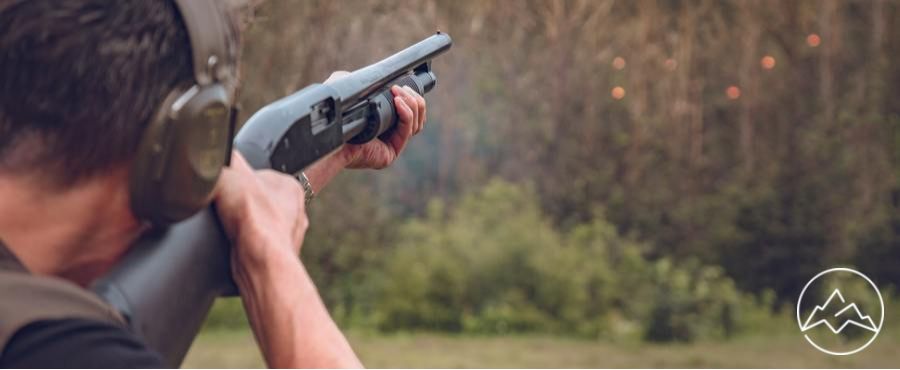What is trap shooting? Trap shooting, often called skeet shooting, is attempting to hit a small clay object flying away from you upwards of 50 miles per hour. It is a sport that requires a militant devotion to technique and an immense amount of practice.
The beauty of shooting trap is that while the rules and procedures remain the same, the act of shooting the clay targets is different for every single shot. Since no two shots are the same, it is critical that trap shooters maintain proper technique, from holds to movement and stance.
Skeet shooting, on the best of days, is a difficult sport. Therefore, we’ll go through several trap shooting tips to improve your game and help you break more sporting clays. Anyone looking to get into the sport of trap shooting, or those who already shoot but want to improve, these tips will help you understand how to hit the clays more frequently.
Pro tip: Remember to pack your gun in a proper gun range bag when traveling to and from the trap shooting range.
#1 – Don’t look at the gun
Many trap experts will tell you to follow the clay with your eyes, not the barrel of your gun. New shooters often follow the target with their gun, leading to chasing. Chasing the target often leads to firing behind and below, missing the target.
There is a small window right above the house where the clay will always pass through. While it is a strategy to aim for this small window, beginners are better served to knock the clay out of its path at a higher trajectory. Attempting to hit the clay right out of the house is difficult, since the direction is random, and only recommended for more advanced shots.
Watch the clay target with your eyes, and your hands will follow. This old axiom proves true in trap shooting when attempting to quickly align your barrel with the target results in missed shots. Focusing on a specific part of the clay will also help with accuracy and get your mind away from merely moving the gun.
Finally, when lining up your shot, make sure you adhere to these basic shotgun shooting techniques:
- Keep your cheek on the stock
- Eyes open (both of them to avoid eye dominance)
- Grip the shotgun with even pressure
#2 – Follow your shot through
No, we aren’t talking about shooting a basketball or swinging a golf club. In terms of getting an accurate shot, all trap shooters should be practicing their shooting follow-through. When discharging the shotgun, shooters should continue the motion of their body, arms, and hands as it was before firing.
Applying continuous motion will ensure the accuracy of the shot as it travels through the barrel. A quick jerk and flinch immediately on firing can cause you to miss the clay. Even slight, imperceptible movements can alter a shot. Using a smooth rhythm to continue your movement takes practice, but will help your accuracy tremendously.
#3 – Quick shots
Shooting trap relies on quick instincts. Thus the tendency for beginners to hesitate is real and detrimental to their accuracy when clay shooting. As the clay gets further away, the ability of the shot to hit the clay diminishes rapidly. Pellets spread out very quickly, and hitting anything beyond 30 meters is more difficult.
Straight throws from the house move away from the shooter the fastest. Since these clays move out of range quickly, it is important to get a quick shot. Luckily, straight throws are the easiest to hit.
For those at stations 4 and 5, hitting the right-angle shots requires you to lead your aim by several inches. Again, this is another instance where it is important to get your shot off quickly. Since you are aiming ahead of the clay, you must fire all the more quickly.
#4 – Use a proper stance
With so much concern about the gun, aiming, and following the clay with your eyes, it’s a wonder that the shooter’s stance gets overlooked. Much like swinging a golf club or a baseball bat,your feet are one of the primary determinants as to where your shot will end up.
Typically, your feet should be in line with the trajectory of the furthest left angle shot trajectory from the 5th shooting position. While this can change slightly, either way, it is a good rule of thumb to follow. Of course, if you are left-handed, then it is the opposite. Make sure your feet are always shoulder width apart with knees slightly bent.
#5 – Don’t rush the call
Some trap shooters like to call immediately after bringing the gun to the ready position. While this may work for experienced shooters, beginning shooters should take their time. Visualizing each shot with the gun to the shoulder is an effective way to improve accuracy.
Lifting the gun and firing immediately also risks your accuracy. Ideally, you want to space out your calls equally. Every shooter wants to get into a rhythm, and quick calls inevitably lead to a shooter getting out synch. Develop an internal routine that allows you to line up your shot, focus, and then call.




Hello Trey,
I live in Poland and the Russian invasion on Ukraine inspired me to return to my shooting practices. Currently I am waiting for my gun permission, so I plan to buy my first over-under shotgun in July.
Could you please recommend a good book or a PDF publication presenting basics of trap and skit – so I could have a “handbook” to practice with.
(Unfortunately, here in Poland clay shooting can take place only in the shooting range area, that are much more rare that in the USA. You cannot just go on the desert.)